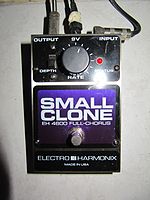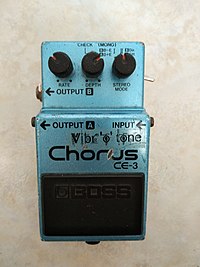

This article needs additional citations for verification. Please help improve this articlebyadding citations to reliable sources. Unsourced material may be challenged and removed.
Find sources: "Chorus" audio effect – news · newspapers · books · scholar · JSTOR (December 2022) (Learn how and when to remove this message) |
Chorus (orchorusing, choruserorchorused effect) is an audio effect that occurs when individual sounds with approximately the same time, and very similar pitches, converge. While similar sounds coming from multiple sources can occur naturally, as in the case of a choirorstring orchestra, it can also be simulated using an electronic effects unit or signal processing device.
When the effect is produced successfully, none of the constituent sounds are perceived as being out of tune. It is characteristic of sounds with a rich, shimmering quality that would be absent if the sound came from a single source. The shimmer occurs because of beating. The effect is more apparent when listening to sounds that sustain for longer periods of time.
The chorus effect is especially easy to hear when listening to a choir or string ensemble. A choir has multiple people singing each part (alto, tenor, etc.). A string ensemble has multiple violinists and possibly multiples of other stringed instruments.
Although most acoustic instruments cannot produce a chorus effect by themselves, some instruments (particularly, chordophones with multiple courses of strings) can produce it as part of their own design. The effect can make these acoustic instruments sound fuller and louder than by using a single tone generator (b.e.: a single vibrating string or a reed). Some examples:
However, while the open strings of a standard-tuned guitar (or any single-stringed instrument like ukuleles, banjos, etc.) can't produce any chorus effect, it can also be obtained by the use of alternative tunings (such as the unisons-and-octaves-only "ostrich tuning" by Lou Reed); by playing chords or fingerings with "redundant" notes (like playing the open high E string and the same "E" note on the 5th fret of the B string); and/or by using extended techniques like bending while playing a note (like playing the 5th fret on the 2nd string and, simultaneously, playing a full-tone bending in the 7th fret on the 3rd string).
Ensembles of instruments and voices can produce a natural chorus effect, such as with a string orchestraorchoir.


The chorus effect can be simulated by a range of electronic and digital effects units and signal processing equipment, including software effects. The signal processor may be software running on a computer, software running in a digital effect processor, or an analog effect processor. If the processor is hardware-based, it may be packaged as a pedal, a rack-mount module, a table-top device, built into an instrument amplifier (often an acoustic guitar amplifier or an electric guitar amplifier), or even built into some electronic instruments, such as synthesizers, electronic pianos and Hammond organs.
The effect is achieved by taking an audio signal and mixing it with one or more delayed copies of itself. The pitch of the added voices is typically modulated by an LFO, which is implemented similarly to a flanger, except with longer delays and without feedback. In the case of the synthesizer, the effect can be achieved by using multiple, slightly detuned oscillators for each note, or by passing all the notes played through a separate electronic chorus circuit.
Stereo chorus effect processors produce the same effect, but it is varied between the left and right channels by offsetting the delay or phase of the LFO. The effect is thereby enhanced because sounds are produced from multiple locations in the stereo field. Used on instruments like "clean" (undistorted) electric guitar and keyboards, it can yield very dreamy or ambient sounds. Commercial chorus effect devices often include controls that enable them to be used to also produce delay, reverberation, or other related effects that use similar hardware, rather than exclusively as chorus effects.
In spite of the name, most electronic chorus effects do not accurately emulate the acoustic ensemble effect. Instead, they create a constantly moving electronic shimmer. Some pitch shift pedals create a slightly detuned unison effect which is more similar to the acoustic chorus sound.
Although the electronic chorus effect can be obtained by the multiple ways mentioned above, some devices have acquired a high status among musicians, especially in the "effect pedal" form.

Some examples of the use of "obviously chorused guitar tracks" include Red Hot Chili Peppers' "Soul to Squeeze" (0:00), Fripp & Eno's "Evensong" (0:37), Guns N’ Roses “Paradise City” (0:00),Nirvana's "Come As You Are" (0:00, clearest at 0:48), Mike Stern's "Swunk" (0:00), and Satellite Party's "Mr. Sunshine" (0:19, right channel).[2] The chorus effect was also a prominent hallmark of guitarist Andy Summers ("The Police"; Tracks: "Don't Stand so Close to Me", "Walking on The Moon", "Every Breath You Take").
|
| |
|---|---|
| Engineering |
|
| Signal processing |
|
aesthetics |
|
professions |
|
| Other |
|